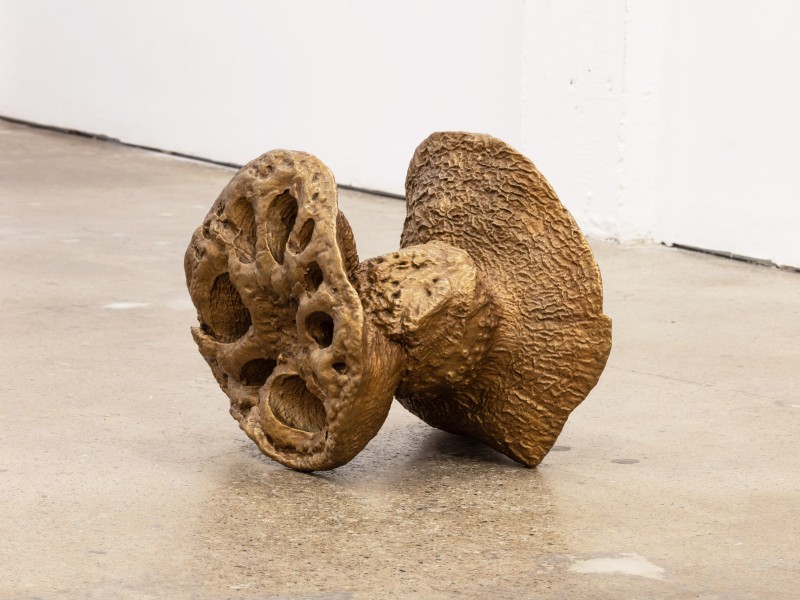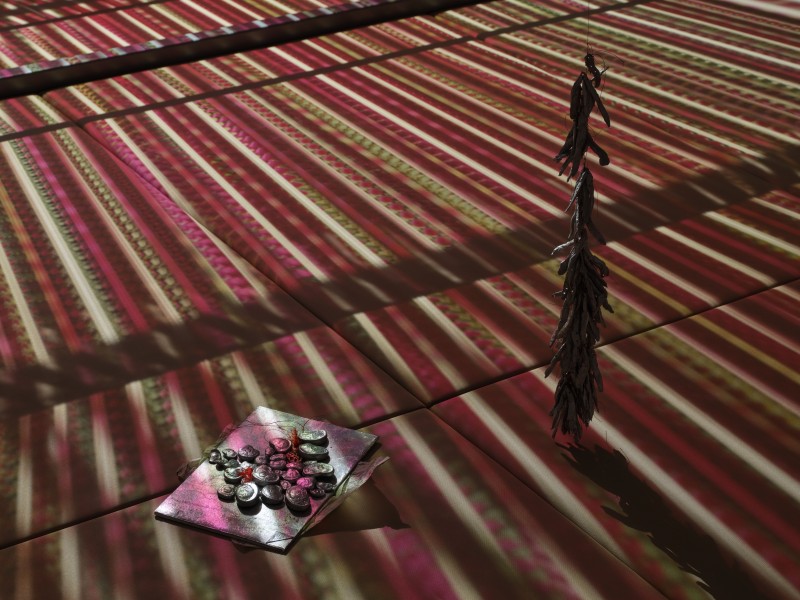Established in 1998 as a public forum for discussing and presenting leading-edge art and culture, the
CCA Wattis Institute for Contemporary Arts works with artists in two distinct ways: as an exhibition space and as a research institute. Following its move to the unified California College of the Arts San Francisco campus in 2024, the Wattis is entering a new chapter.
 Lotus L. Kang, Root, 2022. Cast aluminum. Courtesy the artist
Lotus L. Kang, Root, 2022. Cast aluminum. Courtesy the artist
 Lotus L. Kang, Azaleas, 2024 (detail). Powder coated steel and aluminum, 35 mm film, stepper motor, relays, controllers, sound, stage lights, cables, upholstered wood base, cast-aluminum anchovies, nylon, cast-bronze cabbage leaf, cast-aluminum book, cast-aluminum intervertebral discs, cast-bronze lotus root, tissue paper, polypropylene, plastic pears, plastic bags, compressed moxa, styrofoam, and spirits. Courtesy the artist and Commonwealth and Council, Los Angeles. Photo: Paul Salveson
Lotus L. Kang, Azaleas, 2024 (detail). Powder coated steel and aluminum, 35 mm film, stepper motor, relays, controllers, sound, stage lights, cables, upholstered wood base, cast-aluminum anchovies, nylon, cast-bronze cabbage leaf, cast-aluminum book, cast-aluminum intervertebral discs, cast-bronze lotus root, tissue paper, polypropylene, plastic pears, plastic bags, compressed moxa, styrofoam, and spirits. Courtesy the artist and Commonwealth and Council, Los Angeles. Photo: Paul Salveson
As the Wattis adapts, its curatorial vision centers on making art public through commissioning new work, investing in research-based exhibitions, and building long-term collaborations with artists. Daisy Nam, Jeanne Gerrity, and Diego Villalobos each contribute to this vision with a distinct focus: artist-led processes, international and diasporic dialogues, accessibility, and publishing.
In fall 2025, the Wattis’s research program will focus on the theme of labor, using the historic workers’ slogan “Eight hours of work, eight hours of rest, and eight hours of what you will” as a framework. The galleries will be transformed into a discursive space that hosts reading groups, talks, and installations in order to think alongside the public, artists, and writers such as Carol Becker, Makeda Best, Tania Candiani, Carl Carlsson, Josh Kline, Chantal Peñalosa Fong, and SoiL Thornton. In spring 2026, Venue, a new outdoor commissioning series, will launch with a performance and sound installation by Jeremy Toussaint-Baptiste. This series aims to create a dynamic gathering place for students and Bay Area audiences. The following season, Justin Caguiat and Rafael Delacruz will collaborate on a film, outdoor installation and exhibition. In the fall, Lotus L. Kang will present her first outdoor sonic sculpture on the plaza adjoining the Wattis. The Wattis artist residency program will relaunch in fall 2026 with CFGNY, a collective of four artists—Daniel Chew, Ten Izu, Kirsten Kilponen, and Tin Nguyen—whose ongoing dialogue on the intersections of art, fashion, and identity will engage the campus community.
 Jeremy Toussaint-Baptiste, Unmarked Car (S.L.A.B.), pt. 2, 2024 (performance view). Produced by Hauser & Wirth. Hauser & Wirth, Los Angeles, June 8, 2024. Photo: Cassidy Araiza
Jeremy Toussaint-Baptiste, Unmarked Car (S.L.A.B.), pt. 2, 2024 (performance view). Produced by Hauser & Wirth. Hauser & Wirth, Los Angeles, June 8, 2024. Photo: Cassidy Araiza
Daisy Nam is Director and Chief Curator of the CCA Wattis Institute for Contemporary Arts. She was previously at Ballroom Marfa, where she organized exhibitions such as STEADY: Michelle Lopez and Ester Partegàs (2024); Ecstatic Land (2022); and Donna Huanca: Espejo Quemada (2021), among others. From 2015–19, Nam served as Assistant Director at the Carpenter Center for the Visual Arts at Harvard University (Cambridge, MA). Previously, she served as Assistant Director of Public Programs at Columbia University's School of the Arts (New York). Nam was the coeditor of Best! Letters from Asian Americans in the arts (n+1, 2021). She is currently on the board of Voices in Contemporary Art. Nam holds an MA in Curatorial and Critical Studies from Columbia University and a BA in Art History and Cinema Studies from New York University.
Diego Villalobos is a curator from Cuernavaca, Mexico, currently living and working in San Francisco. He serves as Associate Curator at the Wattis. Villalobos recently organized or co-curated Viaje a la luna (A trip to the moon, 2025); Anicka Yi is on our mind (2023–24); Rodrigo Hernández: with what eyes? (2023–24); Drum Listens to Heart: Live Performances (2022–23); and Mirra Helen: Leaves 1992–2022 (2022). From 2016–19, he was a curator at 500 Capp Street (San Francisco). Villalobos previously served on the board of directors of San Francisco Cinematheque (2020–23). He holds a BFA in New Genres from the San Francisco Art Institute.
Jeanne Gerrity is Deputy Director and Director of Programs at the Wattis, where she has worked since 2016. She recently organized or co-curated Hiwa K is on our mind (2024–25), All This Soft Wild Buzzing (2024), and Anicka Yi is on our mind (2023–24). Prior to the Wattis, she held positions at the Contemporary Jewish Museum and Southern Exposure (both in San Francisco), as well as Smack Mellon and the Lower Manhattan Cultural Council (both in New York). Gerrity is the founding coeditor of the annual publication A Series of Open Questions, and coeditor of Cecilia Vicuña: Word Weapons (2023) and Dodie Bellamy is on our mind (2020). Along with contributing to museum and gallery catalogues, she writes for Artforum, Frieze, and Art Agenda, among other magazines. Gerrity holds an MA in Modern Art: Critical and Curatorial Studies from Columbia University and a BA in Art History from Brown University.
Published August 27, 2025.
 Lotus L. Kang, Root, 2022. Cast aluminum. Courtesy the artist
Lotus L. Kang, Root, 2022. Cast aluminum. Courtesy the artist Lotus L. Kang, Azaleas, 2024 (detail). Powder coated steel and aluminum, 35 mm film, stepper motor, relays, controllers, sound, stage lights, cables, upholstered wood base, cast-aluminum anchovies, nylon, cast-bronze cabbage leaf, cast-aluminum book, cast-aluminum intervertebral discs, cast-bronze lotus root, tissue paper, polypropylene, plastic pears, plastic bags, compressed moxa, styrofoam, and spirits. Courtesy the artist and Commonwealth and Council, Los Angeles. Photo: Paul Salveson
Lotus L. Kang, Azaleas, 2024 (detail). Powder coated steel and aluminum, 35 mm film, stepper motor, relays, controllers, sound, stage lights, cables, upholstered wood base, cast-aluminum anchovies, nylon, cast-bronze cabbage leaf, cast-aluminum book, cast-aluminum intervertebral discs, cast-bronze lotus root, tissue paper, polypropylene, plastic pears, plastic bags, compressed moxa, styrofoam, and spirits. Courtesy the artist and Commonwealth and Council, Los Angeles. Photo: Paul Salveson Jeremy Toussaint-Baptiste, Unmarked Car (S.L.A.B.), pt. 2, 2024 (performance view). Produced by Hauser & Wirth. Hauser & Wirth, Los Angeles, June 8, 2024. Photo: Cassidy Araiza
Jeremy Toussaint-Baptiste, Unmarked Car (S.L.A.B.), pt. 2, 2024 (performance view). Produced by Hauser & Wirth. Hauser & Wirth, Los Angeles, June 8, 2024. Photo: Cassidy Araiza